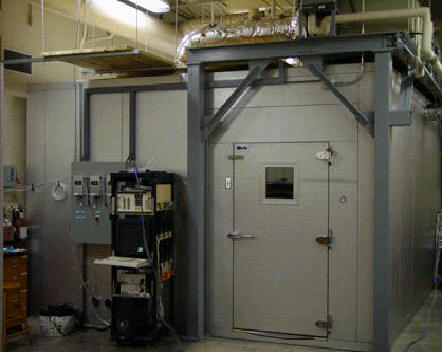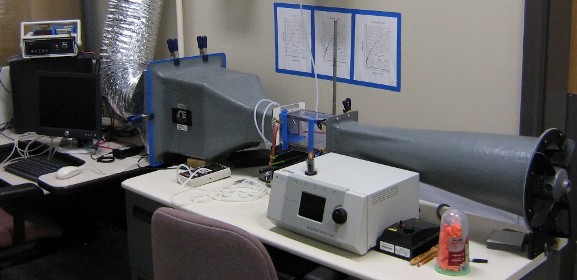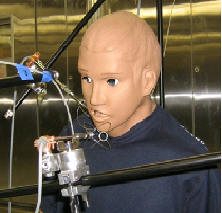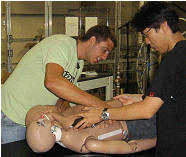

Assistant Professor
Department of Civil, Architectural, and Environmental Engineering
University of Texas at Austin
Laboratories:
Air Pollutant and Energy Flow Testing Facility
The unique in the air pollutant and energy flow test facility is a part of a large laboratory for indoor air quality studies at UT Austin. 1,000 sf
of laboratory space and state of the art instrumentation are dedicated to various studies related to the performance of building environmental systems considering energy efficiency and indoor environmental quality.One of the largest equipments in this laboratory is a test chamber. It is a precisely controlled environmental chamber with size of 6×4.5×3m (20×15×10ft). The control capabilities of this chamber can enable various experiments where certain groups of indoor parameters are controlled while other groups of parameters are measured. The chamber walls with R=5.3 m2K/W (R=30 ft2 °Fh/Btu) insulate the chamber from external influences, and provide a precise control of mass and energy balance in the chamber space. One external wall is hydronic cooled / heating and the remaining chamber walls are equipped with electric surface heating panels.


The Air Handling Unit (AHU) of the chamber supports a wide range of environmental conditions. It provides up to 25 Air Changes per Hour (ACH) and has a capability to operate in the range 0 -100% of make-up air. It can provide a wide range of temperatures and relative humidities in the chamber. The AHU is connected with the chamber and the position of inlet and outlet diffusers is adjustable either in the suspended ceiling or the raised floor plenum. The metal frame of the chamber supports movable raised floor and suspended ceiling and enable vertical partitioning of the chamber.
A digital control system is designed to provide precise control of the set-variables for both steady-state and variable heating/cooling loads in the chamber. The AHU and control system are designed to be flexible and adaptable for various types of steady-state and unsteady-state experiments. An integral part of the environmental chamber is the air flow measuring system. It consists of three calibrated flow stations positioned in supply and return ducts with the precision of 5% of the reading value.

The measuring equipment of the test chamber consists of several additional systems: (1) a system for surface and air temperature measurements, (2) an air velocity measuring system, and (3) a gas concentration and 4) an aerosol concentration/size measuring system.
The surface and air temperate measuring system consist of 108 thermistors where half are distributed along the chamber surfaces. These surface temperature sensors provide information on temperatures of various sections of the chamber needed for the calculation of surface to surface radiative heat transfer and convective heat flux analyses. The other set of indoor thermistors measures spatial temperature distribution in different experimental setups.
The air velocity measuring system consists of 19 low velocity omni-direction air speed sensors and 8 ultrasonic 3-D sensors with capability to measure high frequency fluctuation of velocity. The sensors are distributed in the space to measure specific velocity field. Close to the diffuser are fast ultrasonic sensors while in the central zone of the room and close to the thermal manikin are low velocity omni-directional sensors.
The tracer gas measuring system measures SF6 gas concentrations at various places in the space, needed for age-of-air and ventilation effectiveness calculation. This measuring system is also used for control measurements of supply volume flow rates in the chamber. The tracer gas system encompasses a subsystem for release of tracer gas and a subsystem for tracer gas sample collection and analysis. The two device for sample collection and analysis are AUTOTRAC gas chromatographers that automatically collect air samples at 18 different positions in the space.The particle measuring equipment includes two Collison Nebulizers, six TSI Aerotrack particle counters, one TSI Aerodynamic Particle Seizer (APS), and a wind tunnel for calibration of Aerotrack particle counters. The two Collison Nebulizer have different particle generation rate and they are used to mimic intermittent or continuous particle source in the chamber.


Dr. Novoselac has a large variety of thermal manikins used in human exposure studies. The geometry and functionality of these thermal manikins vary from simple cylinders with heat flux control to detailed thermal models with capability to breath and move limbs.

The UTest House is a fully instrumented 1300 ft2 manufactured home used for education and research in indoor environmental science and engineering. It is purchased from the NSF IGERT grant, and it is located at the Pickle Research Center. The house has seven building rooms/zones and two heating ventilation and air-conditioning (HVAC) systems; the first one with ceiling and the second with floor air distribution system. Even though there are several similar test houses in the U.S., none of them is equipped to perform such detailed monitoring indoor air quality and energy performance. The permanently installed equipment that is the heart of the building performance measuring apparatus includes systems for:


Beside this permanent equipment, the house is equipped with numerous portable instruments for assessment of: indoor air quality, material emission, and indoor chemistry. These include various particle generation systems and particle concentration monitors for the particle range form 10 nm to 10 µm. Also, the house is equipped with automatic air sampling systems for: tracing reactive and noncreative gases emitted from various building materials. It also includes a portable ozone generation system with multiple ozone monitors. To simulate a realistic indoor environment, the test house is equipped with a system that mimics human occupancy. A set of heaters and steam humidifiers with timers, distributed within the house, simulates this human impact on indoor environment and building energy consumption. Almost all measuring systems are remotely controlled from the student and faculty offices; a virtual interface enables the real-time monitoring of experiments and provides students and faculties with capability to control the experiments without being in the house.
The house and measuring systems were assembled in the spring 2008, and since then it was used in multiple courses and research projects. These courses include: Indoor Air Quality: Field Measurements, Design of Energy Efficient and Healthy Buildings, and HVAC Design. In these courses graduate and undergraduate students use the UTest house to learn about experimental research methods and explore fundamental engineering phenomena in a realistic setting.
Also, more than half a dozen IGERT trainees and affiliates have been using the UTest house for their research projects. These projects are:
Passive reduction of human exposure to indoor ozone. This project investigates the energy efficient methods for indoor ozone removal by use of activated carbon and unpainted gypsum wallboard panels. These experiments in the test house have been used for development of ozone transport models in indoor residence with airflow drive by natural and forced convection.
Impact of placement of portable air cleaning devices in multizone residential environments. This project investigates the variation of overall particle removal and human exposure reduction for different positions of portable cleaning device in the residence. The test house was used for the development and validation of computational fluid dynamics (CFD) models used in this study.
Energy implications of filtration in residential buildings. The project explores the effects of high, medium and low efficiency filters on energy consumption in residential buildings. As a part of this project, energy consumption in various components of the HVAC systems of the UTest house was monitored with different filters over the period of 10 months.
Transport of contaminants between indoor and outdoor environment. The focus of this project is on the effects that natural ventilation has on transport of particulate maters between indoor and outdoor environments and on human exposure to particulate contaminants. Experiments that included measurements of indoor and outdoor airflow, turbulence fluctuation and pressure distribution have been used for development of airflow models..
Biological and metal contaminants in HVAC filter dust. This research focuses on microbial contaminants and metals captured on HVAC filters of residential buildings. It develops correlations between concentration of these contaminants in the dust samples collected at various positions in the house and in the filter mass. The test house was used for experimental method development and is one of the seventeen experimental sites used in this study.